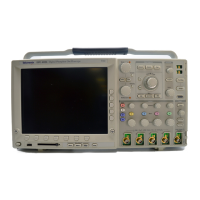7. Use the default name for your file, type a unique name into the Name text box, or select an existing name from the Name list
(data in the existing file will be overwritten). You can also select the Auto-increment file name check box to save a series of
files without typing in a new name each time.
8. Select the file type from the Save as type drop-down list; this is the same as the Measurement format that you selected in
the Options dialog box.
■
Use .cvs for spreadsheets.
■
Use .txt for text.
NOTE. Changing the file type here will also change the selected format in the Option dialog.
9. Click Save.
Creating and using math waveforms
Using math waveforms
Use the same techniques to work with math waveforms that you use with channel waveforms. This procedure demonstrates
some common operations that you can perform on math waveforms:
NOTE. Math calculations are not available on digital channels.
NOTE. Each math waveform you create derives its horizontal scale and position from the sources you include in its math
expression. You can adjust these controls for the source waveforms, and your adjustments are reflected in the math waveform.
You can also magnify math waveforms using MultiZoom, and use the mouse for positioning.
How to ?
598 DPO70000SX, MSO/DPO70000DX, MSO/DPO70000C, DPO7000C, and MSO/DPO5000B Series

